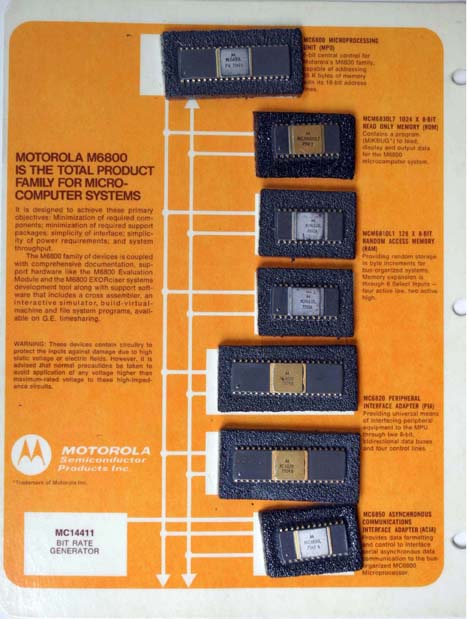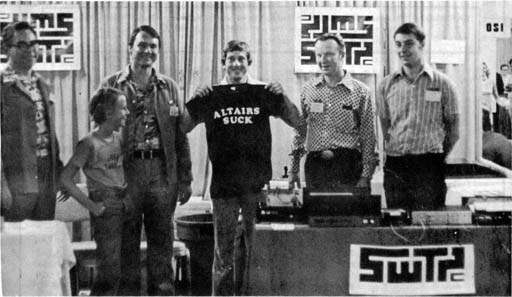.
Michael Holley August 2005
What computers were you familiar with before the 6800 design?
I learned Fortran programming on Trinity University's IBM 1800 computer when I was a Freshman in college in 1967. That was my first experience with computers. Fortran IV programming and drafting were the first two engineering specific courses required for all freshman engineering science majors. I did not start working part time at SWTPC until either December 1967 or January 1968 so I had several months to occasionally spend evenings at the computer center in the Fall of 1967 “playing” with the computer. A number of my fellow engineering students at the time were so fascinated with the computer they decided to switch majors from engineering science to computer science. I really enjoyed working with the computer, but was not obsessed with it and decided to remain in engineering.
In the early 70’s after I was a full time SWTPC engineer, Dan Meyer expressed interest in getting a computer for the company to help with order entry, inventory, etc. I was the only one at the company at the time that had any experience with computers of any kind. I volunteered to be involved in both the selection of the computer and to do its programming. Most of the computers we looked at over several months were categorized “Minicomputers” and made by companies like Data General and Hewlett Packard. They were microwave oven sized rack mount units with status LED and switch covered front panels. All of the computers we were considering at the time required an ASR33 teletype and paper tape reader to boot the computer, even when operated with a hard disk and disk operating system. One of the last units we looked at was a Datapoint 2200. (Dan Meyer talks about this computer here.)
Datapoint was a San Antonio based company and their computer was different from the others in that it was a desktop unit that looked more like a video terminal than a Minicomputer. It did not require a paper tape reader to boot the hard disk. It instead it booted from what looked like an integrated, conventional dual cassette tape read/write unit located on the top rear of the enclosure. You could use this same computer without a hard disk, using just the tapes for both data and program storage; referred to as a cassette tape operating system (CTOS). Datapoint offered a business oriented BASIC like language called Databus/Datashare instead of RPG and Cobol offered by the Minicomputer companies. The manuals for the Databus language were good enough that I felt confident that I could program computer without additional help or training. I was not pleased with the RPG and Cobol documentation I had seen from Datapoint’s competitors.

(Datapoint 2200 own by Jack Rubin)
(Compare the 2200 case style to the SWTPC
CT-82 Terminal.)
The Datapoint 2200 computer system which included the integrated computer/terminal, printer, one fixed 2.5 Mbyte hard drive and one removable 2.5 Mbyte hard drive was actually less expensive than any of the competitive systems we had been considering. Everybody involved with the selection of the computer agreed that the Datapoint looked to be the best choice. It also made sense that the service and support would be better than any if its competitors because the company was located here in San Antonio. While we were waiting for delivery, Datapoint let me use their demo computers at their local sales office to get started on its programming which included programs for order entry, inventory control and mailing list. Virtually everybody at the company was pleased with Datapoint 2200 computer when it arrived. It did not take long to get the programs up and running. Its hardware and software were expanded over the years to support the addition of several terminals. That same computer was still the only computer being used for the company’s business operations when I left the company in March of 1984.
Why did you choose the 6800?
 As
I recall, SWTPC had been using its Datapoint 2200 computer a year or two
before the MITS Altair computer article was published. We considered
building an 8008 based computer based design shortly after the article
appeared, but the design never got very far along. One day Dan Meyer
walked up to my workbench and handed me a blister pack of Motorola IC’s
that included if I am remembering correctly the MC6800, MC6820, MC6830
and MC6850; and then said something like “Here, build this”. It really
was a blister pack with a conductive foam base. I had to use an Xacto
knife to cut the IC’s out. I think he said he had paid $500 for the IC’s
but that may just have been Motorola’s selling price at the time.
As
I recall, SWTPC had been using its Datapoint 2200 computer a year or two
before the MITS Altair computer article was published. We considered
building an 8008 based computer based design shortly after the article
appeared, but the design never got very far along. One day Dan Meyer
walked up to my workbench and handed me a blister pack of Motorola IC’s
that included if I am remembering correctly the MC6800, MC6820, MC6830
and MC6850; and then said something like “Here, build this”. It really
was a blister pack with a conductive foam base. I had to use an Xacto
knife to cut the IC’s out. I think he said he had paid $500 for the IC’s
but that may just have been Motorola’s selling price at the time.
Southwest Technical had a very close relation with Motorola for
most of its history so there is certainly a likelihood that Dan Meyer
would have preferred to do business with Motorola over Intel if he had
the choice. Furthermore, Motorola’s concept of offering their ROM based
MIKBUG software that supported
video monitor and teletype use without the need for a front panel full
of switches and status LED’s fit right in with our reasons for liking
the Datapoint 2200. Over the next few weeks I got the blister pack of
IC’s communicating with an ASR33 teletype having an integral paper tape
reader that the company purchased just for that project. There was no
resident 6800 assembler at the time so the early programs were generated
by hand keying machine code onto paper tape and then loading the paper
tape programs from the ASR33 teletype using the MIKBUG loader. We had
intermittent problems with serial communication when using either the
ASR33 or a video monitor and eventually traced it to a bug in Motorola’s
MIKBUG monitor program that I believe was associated with starting a
serial transmission after receiving only half of a stop bit. We fixed
the bug, added some other stuff and called it
SWTBUG.
Did you expect the design to last as long as it did?
Actually, it wasn’t long before the 6800 was replaced with the 6809 and when I left the company in March of 1984 work was being done on a 68000 based design. Yes, I am surprised that people today are collecting and using SWTPC products including the 6800 and 6809 based computers. Computers have obviously come a long way in the last 30 years. I am not particularly surprised by the proliferation of computers into the business environment, but I never expected personal computers to be as popular as they are today. But then of course the personal computer has become the gateway to the Internet.

What was early 1976 like? Hectic? Exciting? Overworked?
SWTPC was a nice place to work. It was not a high paying company but it was a very casual and relaxed environment. Many of us got to wear lots of different hats so to speak so we learned a lot. So far as overtime is concerned, Dan Meyer would jokingly tell employees if he caught them in the building after hours that he was going to charge them rent. His wife told me once that when he worked at Southwest Research Institute, management would often call meetings just when it was time to go home. He apparently vowed to never run a business like that. SWTPC is also probably one of the only businesses to have free soft drinks available to its employees. Mr. Meyer as we called him had several refrigerators throughout the company and kept them all stocked with a variety of bottled soft drinks. Employees were welcome to have as many as they wanted throughout the day during breaks, lunch or whenever. Working on the computer was fun and exciting at the time, but I personally was not obsessed with it.
Joe Deres and I did most of the initial 6800 design. I probably did most of the hardware and Joe more the software. Joe Deres spent a lot of time working with Robert Uiterwyk who independently wrote a Basic language interpreter for the computer. I was fielding technical phone calls one day when out of the blue, this guy in Florida (Robert) calls and says he is going to write a Basic Interpreter to run on our computer. Yea, Sure; but he did it. It was a busy time because the computer related projects generated the need for more phone support and convention personnel so we had to do this work in addition to our design responsibilities. But once again, working overtime was discouraged, not encouraged.

Personal Computing Convention, August 1976 in Atlantic City, New Jersey
Pictured above from left to, right are Bill Thames, Rep. of Microcomputer Systems; Ted Uiterwyk, Software Debugger; Robert Uiterwyk, Author of Microbasic and 4K Basic; Gary Kay, SWTPC Engineer; Dan Meyer President of SWTPC; and Joe Deres, SWTPC Engineer. (Photo by Jim Stratigos.)
The show management would not let them wear the Altairs Suck shirts.